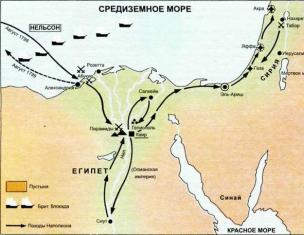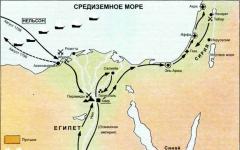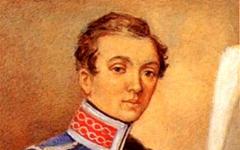« Physics - 11th grade"
The structure of the atomic nucleus. Nuclear forces
Immediately after the neutron was discovered in Chadwick's experiments, Soviet physicist D. D. Ivanenko and the German scientist W. Heisenberg in 1932 proposed a proton-neutron model of the nucleus.
It was confirmed by subsequent studies of nuclear transformations and is now generally accepted.
Proton-neutron model of the nucleus
According to the proton-neutron model, nuclei consist of elementary particles two types - protons and neutrons.
Since the atom as a whole is electrically neutral, and the charge of a proton is equal to the modulus of the charge of an electron, the number of protons in the nucleus is equal to the number of electrons in the atomic shell.
Therefore, the number of protons in the nucleus is equal to the atomic number of the element Z in the periodic system of elements by D.I. Mendeleev.
The sum of the number of protons Z and number of neutrons N in the kernel is called mass number and denoted by the letter A:
A = Z + N
The masses of a proton and a neutron are close to each other and each of them is approximately equal to an atomic mass unit.
The mass of electrons in an atom is much less than the mass of its nucleus.
Therefore, the mass number of the nucleus is equal to the relative atomic mass of the element rounded to a whole number.
Mass numbers can be determined by approximately measuring the mass of nuclei using instruments that are not highly accurate.
Isotopes are nuclei with the same value Z, but with different mass numbers A, i.e. with different numbers of neutrons N.
Since nuclei are very stable, protons and neutrons must be held inside the nucleus by some forces, and very strong ones at that.
This is not gravitational forces that are too weak.
The stability of the nucleus cannot be explained by electromagnetic forces either, since electric repulsion operates between like-charged protons.
And neutrons have no electrical charge.
This means that between nuclear particles - protons and neutrons, they are called nucleons- there are special forces called nuclear forces.
What are the main properties of nuclear forces? Nuclear forces are approximately 100 times greater than electrical (Coulomb) forces.
These are the most powerful forces of all existing in nature.
Therefore, the interactions of nuclear particles are often called strong interactions.
Strong interactions manifest themselves not only in the interactions of nucleons in the nucleus.
This is a special type of interaction inherent in most elementary particles along with electromagnetic interactions.
Another important feature of nuclear forces is their short duration.
Electromagnetic forces weaken relatively slowly with increasing distance.
Nuclear forces noticeably manifest themselves only at distances equal to the size of the nucleus (10 -12 -10 -13 cm), as Rutherford's experiments on the scattering of α-particles by atomic nuclei already showed.
A complete quantitative theory of nuclear forces has not yet been developed.
Significant progress in its development has been achieved quite recently - in the last 10-15 years.
The nuclei of atoms consist of protons and neutrons. These particles are held in the nucleus by nuclear forces.
Isotopes
The study of the phenomenon of radioactivity led to important discovery: the nature of atomic nuclei was clarified.
As a result of observing a huge number of radioactive transformations, it was gradually discovered that there are substances that are identical in their chemical properties, but have completely different radioactive properties (that is, they decay differently).
They could not be separated by any of the known chemical methods.
On this basis, Soddy in 1911 suggested the possibility of the existence of elements with the same chemical properties, but differing, in particular, in their radioactivity.
These elements must be placed in the same cell periodic table D. I. Mendeleev.
Soddy called them isotopes(i.e. occupying the same places).
Soddy's assumption received brilliant confirmation and profound interpretation a year later, when J. J. Thomson made precise measurements of the mass of neon ions by deflecting them in electric and magnetic fields.
He discovered that neon is a mixture of two types of atoms.
Most of them have a relative mass of 20.
But there is a small fraction of atoms with a relative atomic mass of 22.
As a result, the relative atomic mass of the mixture was taken to be 20.2.
Atoms that have the same chemical properties differ in mass.
Both types of neon atoms, naturally, occupy the same place in D.I. Mendeleev’s table and, therefore, are isotopes.
Thus, isotopes can differ not only in their radioactive properties, but also in mass.
That is why isotopes have the same charges of atomic nuclei, which means the number of electrons in the shells of atoms and, consequently, chemical properties isotopes are the same.
But the masses of the nuclei are different.
Moreover, nuclei can be both radioactive and stable.
The difference in the properties of radioactive isotopes is due to the fact that their nuclei have different masses.
The existence of isotopes for most chemical elements has now been established.
Some elements have only unstable (i.e. radioactive) isotopes.
The heaviest element existing in nature - uranium (relative atomic masses 238, 235, etc.) and the lightest - hydrogen (relative atomic masses 1, 2, 3) have isotopes.
Hydrogen isotopes are especially interesting, since they differ in mass by 2 and 3 times.
An isotope with a relative atomic mass of 2 is called deuterium.
It is stable (i.e., not radioactive) and appears as a small impurity (1:4500) in ordinary hydrogen.
When deuterium combines with oxygen, so-called heavy water is formed.
Her physical properties noticeably different from the properties of ordinary water.
At normal atmospheric pressure, it boils at 101.2 °C and freezes at 3.8 °C.
An isotope of hydrogen with atomic mass 3 is called tritium.
It is β-radioactive and has a half-life of about 12 years.
The existence of isotopes proves that the charge of the atomic nucleus does not determine all the properties of the atom, but only its chemical properties and those physical properties that depend on the periphery electron shell, for example the size of an atom.
The mass of an atom and its radioactive properties are not determined by the serial number in D.I. Mendeleev’s table.
It is noteworthy that when accurately measuring the relative atomic masses of isotopes, it turned out that they were close to whole numbers.
But the atomic masses of chemical elements sometimes differ greatly from whole numbers.
Thus, the relative atomic mass of chlorine is 35.5.
This means that in its natural state, a chemically pure substance is a mixture of isotopes in various proportions.
The (approximate) integrity of the relative atomic masses of isotopes is very important for elucidating the structure of the atomic nucleus.
Most chemical elements have isotopes.
The charges of the atomic nuclei of isotopes are the same, but the masses of the nuclei are different.
IN late XIX- at the beginning of the 20th century, physicists proved that the atom is a complex particle and consists of simpler (elementary) particles. Were discovered:
· cathode rays (English physicist J. J. Thomson, 1897), the particles of which are called electrons e - (carry a single negative charge);
· natural radioactivity of elements (French scientists - radiochemists A. Becquerel and M. Sklodowska-Curie, physicist Pierre Curie, 1896) and the existence of α-particles (helium nuclei 4 He 2 +);
· the presence of a positively charged nucleus at the center of the atom (English physicist and radiochemist E. Rutherford, 1911);
· artificial transformation of one element into another, for example nitrogen into oxygen (E. Rutherford, 1919). From the nucleus of an atom of one element (nitrogen - in Rutherford’s experiment), upon collision with an α-particle, the nucleus of an atom of another element (oxygen) and a new particle were formed, carrying a unit positive charge and called a proton (p +, 1H nucleus)
· presence in the nucleus of an atom of electrically neutral particles - neutrons n 0 (English physicist J. Chadwick, 1932). As a result of the research, it was found that the atom of each element (except 1H) contains protons, neutrons and electrons, with protons and neutrons concentrated in the nucleus of the atom, and electrons on its periphery (in the electron shell).
Electrons are usually denoted as follows: e − .
Electrons e are very light, almost weightless, but have a negative electrical charge. It is equal to -1. Electric current, which we all use, is a stream of electrons running in wires.
Neutrons are designated as follows: n 0, and protons as follows: p +.
Neutrons and protons are almost identical in mass.
The number of protons in the nucleus is equal to the number of electrons in the shell of the atom and corresponds to the serial number of this element in the Periodic Table.
Atomic nucleus
The central part of an atom, in which the bulk of its mass is concentrated and the structure of which determines the chemical element to which the atom belongs.
Atomic nucleus consists of nucleons - positively charged protons p + and neutral neutrons n 0, which are interconnected through strong interaction. The atomic nucleus, considered as a class of particles with a certain number of protons and neutrons, is often called a nuclide.
The number of protons in a nucleus is called its charge number Z - this number is equal to the atomic number of the element to which the atom belongs in the periodic table.
The number of neutrons in the nucleus is denoted by the letter N, and the number of protons by the letter Z. These numbers are related to each other by a simple ratio:
The total number of nucleons in a nucleus is called its mass number A = N + Z and is approximately equal to the average mass of an atom shown in the periodic table.
Atomic nuclei with the same number of protons and different numbers of neutrons are called isotopes.
Many elements have one natural isotope, for example, Be, F, Na, Al, P, Mn, Co, I, Au and some others. But most elements have two or three most stable isotopes.
For example:
Atomic nuclei with the same number of neutrons, but different numbers of protons are called isotones.
Atoms of different elements with the same atomic mass-A are called isobars.
A feature of radioactive contamination, in contrast to contamination by other pollutants, is that it is not the radionuclide (pollutant) itself that has a harmful effect on humans and environmental objects, but the radiation from which it is a source.
However, there are cases when a radionuclide is a toxic element. For example, after an accident at Chernobyl nuclear power plant V environment plutonium 239, 242 Pu were released with nuclear fuel particles. In addition to the fact that plutonium is an alpha emitter and poses a significant danger when ingested, plutonium itself is a toxic element.
For this reason, two groups of quantitative indicators are used: 1) to assess the content of radionuclides and 2) to assess the impact of radiation on an object.
Activity- a quantitative measure of the content of radionuclides in the analyzed object. Activity is determined by the number of radioactive decays of atoms per unit time. The SI unit of activity is the Becquerel (Bq) equal to one decay per second (1Bq = 1 decay/s). Sometimes used non-systemic unit activity measurements - Curie (Ci); 1Ci = 3.7 ×1010 Bq.
Radiation dose- a quantitative measure of the impact of radiation on an object.
Due to the fact that the impact of radiation on an object can be assessed at different levels: physical, chemical, biological; at the level of individual molecules, cells, tissues or organisms, etc., several types of doses are used: absorbed, effective equivalent, exposure.
To assess the change in radiation dose over time, the “dose rate” indicator is used. Dose rate is the dose-time ratio. For example, the dose rate of external radiation from natural radiation sources in Russia is 4-20 μR/h.
The main standard for humans - the main dose limit (1 mSv/year) - is introduced in units of effective equivalent dose. There are standards in units of activity, levels of land pollution, VLU, GGP, SanPiN, etc.
The structure of the atomic nucleus.
An atom is the smallest particle chemical element, preserving all its properties. According to its structure, the atom is complex system, consisting of a positively charged nucleus of a very small size (10 -13 cm) located in the center of the atom and negatively charged electrons rotating around the nucleus in different orbits. The negative charge of the electrons is equal to the positive charge of the nucleus, while in general it turns out to be electrically neutral.
Atomic nuclei are made up of nucleons - nuclear protons ( Z- number of protons) and nuclear neutrons (N - number of neutrons). “Nuclear” protons and neutrons are different from particles in a free state. For example, a free neutron, unlike one bound in a nucleus, is unstable and turns into a proton and an electron.
The number of nucleons Am (mass number) is the sum of the numbers of protons and neutrons: Am = Z+N.
Proton - An elementary particle of any atom, it has a positive charge equal to the charge of an electron. The number of electrons in the shell of an atom is determined by the number of protons in the nucleus.
Neutron - another type of nuclear particles of all elements. It is absent only in the nucleus of light hydrogen, consisting of one proton. It has no charge and is electrically neutral. In the atomic nucleus, neutrons are stable, but in a free state they are unstable. The number of neutrons in the nuclei of atoms of the same element can fluctuate, so the number of neutrons in the nucleus does not characterize the element.
Nucleons (protons + neutrons) are held within the atomic nucleus by nuclear attractive forces. Nuclear forces are 100 times stronger than electromagnetic forces and therefore hold similarly charged protons inside the nucleus. Nuclear forces manifest themselves only at very short distances (10 -13 cm), they amount to potential energy nuclear bonds, which are partially released during certain transformations, transform into kinetic energy.
For atoms that differ in the composition of the nucleus, the name “nuclides” is used, and for radioactive atoms - “radionuclides”.
Nuclides are called atoms or nuclei with a given number of nucleons and a given nuclear charge (nuclide designation A X).
Nuclides having the same number of nucleons (Am = const) are called isobars. For example, nuclides 96 Sr, 96 Y, 96 Zr belong to a series of isobars with the number of nucleons Am = 96.
Nuclides having the same number of protons (Z = const), are called isotopes. They differ only in the number of neutrons, so they belong to the same element: 234 U , 235 U, 236 U , 238 U .
Isotopes- nuclides with the same number of neutrons (N = Am -Z = const). Nuclides: 36 S, 37 Cl, 38 Ar, 39 K, 40 Ca belong to a series of isotopes with 20 neutrons.
Isotopes are usually denoted in the form Z X M, where X is the symbol of the chemical element; M is the mass number equal to the sum of the number of protons and neutrons in the nucleus; Z is the atomic number or charge of the nucleus, equal to the number of protons in the nucleus. Since each chemical element has its own constant atomic number, it is usually omitted and limited to writing only the mass number, for example: 3 H, 14 C, 137 Cs, 90 Sr, etc.
Atoms of the nucleus that have the same mass numbers, but different charges and, consequently, different properties are called “isobars”, for example, one of the isotopes of phosphorus has a mass number of 32 - 15 P 32, one of the isotopes of sulfur has the same mass number - 16 S 32.
Nuclides can be stable (if their nuclei are stable and do not decay) and unstable (if their nuclei are unstable and undergo changes that ultimately lead to an increase in the stability of the nucleus). Unstable atomic nuclei that can spontaneously decay are called radionuclides. The phenomenon of spontaneous decay of the nucleus of an atom, accompanied by the emission of particles and (or) electromagnetic radiation, called radioactivity.
As a result of radioactive decay, both a stable and a radioactive isotope can be formed, which in turn decays spontaneously. Such chains of radioactive elements connected by a series of nuclear transformations are called radioactive families.
Currently, IUPAC (International Union of Pure and Applied Chemistry) has officially named 109 chemical elements. Of these, only 81 have stable isotopes, the heaviest of which is bismuth (Z= 83). For the remaining 28 elements, only radioactive isotopes, and uranium (U~ 92) is the heaviest element found in nature. The largest natural nuclide has 238 nucleons. In total, the existence of about 1,700 nuclides of these 109 elements has now been proven, and the number of isotopes known for individual elements ranges from 3 (for hydrogen) to 29 (for platinum).
Long before the appearance of reliable data about the internal structure of all things, Greek thinkers imagined matter in the form of tiny fiery particles that were in constant motion. Probably this vision of the world order of things was derived from purely logical conclusions. Despite some naivety and the absolute lack of evidence of this statement, it turned out to be true. Although scientists were able to confirm this bold guess only twenty-three centuries later.
Atomic structure
At the end of the 19th century, the properties of a discharge tube through which current was passed were investigated. Observations have shown that in this case two streams of particles are emitted:
The negative particles of cathode rays were called electrons. Subsequently, particles with the same charge-to-mass ratio were discovered in many processes. Electrons seemed to be universal components different atoms, which are quite easily separated when bombarded by ions and atoms.
Particles carrying a positive charge were represented as fragments of atoms after they had lost one or more electrons. In fact, the positive rays were groups of atoms devoid of negative particles and, as a result, had a positive charge.
Thompson model
Based on experiments, it was found that positive and negative particles represented the essence of the atom and were its components. The English scientist J. Thomson proposed his theory. In his opinion, the structure of the atom and the atomic nucleus was a kind of mass in which negative charges were squeezed into a positively charged ball, like raisins into a cupcake. Charge compensation made the “cupcake” electrically neutral.

Rutherford model
The young American scientist Rutherford, analyzing the tracks left behind by alpha particles, came to the conclusion that Thompson’s model was imperfect. Some alpha particles were deflected at small angles - 5-10 o. In rare cases, alpha particles were deflected at large angles of 60-80 o, and in exceptional cases the angles were very large - 120-150 o. Thompson's model of the atom could not explain the difference.
Rutherford suggests new model, explaining the structure of the atom and the atomic nucleus. The physics of the process states that an atom should be 99% empty, with a tiny nucleus and electrons rotating around it, moving in orbits.

He explains deviations during impacts by the fact that the particles of an atom have their own electrical charges. Under the influence of bombarding charged particles, atomic elements behave like ordinary charged bodies in the macrocosm: particles with the same charges repel each other, and those with opposite charges attract.
State of atoms
At the beginning of the last century, when the first particle accelerators were launched, all theories that explained the structure of the atomic nucleus and the atom itself were waiting experimental verification. By that time, the interactions of alpha and beta rays with atoms had already been thoroughly studied. Up until 1917, it was believed that atoms were either stable or radioactive. Stable atoms cannot be split, and the decay of radioactive nuclei cannot be controlled. But Rutherford managed to refute this opinion.
First proton
In 1911, E. Rutherford put forward the idea that all nuclei consist of identical elements, the basis for which is the hydrogen atom. The scientist was prompted to this idea by an important conclusion from previous studies of the structure of matter: the masses of all chemical elements are divided without a remainder by the mass of hydrogen. The new assumption opened up unprecedented possibilities, allowing us to see the structure of the atomic nucleus in a new way. Nuclear reactions were supposed to confirm or refute the new hypothesis.
Experiments were carried out in 1919 with nitrogen atoms. By bombarding them with alpha particles, Rutherford achieved an amazing result.
The N atom absorbed an alpha particle, then turned into an oxygen atom O 17 and emitted a hydrogen nucleus. This was the first artificial transformation of an atom of one element into another. Such an experience gave hope that the structure of the atomic nucleus and the physics of existing processes make it possible to carry out other nuclear transformations.

The scientist used the scintillation flash method in his experiments. Based on the frequency of flares, he drew conclusions about the composition and structure of the atomic nucleus, the characteristics of the generated particles, their atomic mass and atomic number. The unknown particle was named proton by Rutherford. It had all the characteristics of a hydrogen atom stripped of its single electron - a single positive charge and corresponding mass. Thus, it was proven that the proton and the hydrogen nucleus are the same particles.
In 1930, when the first large accelerators were built and launched, Rutherford's model of the atom was tested and proven: each hydrogen atom consists of a lone electron, the position of which cannot be determined, and a loose atom with a lone positive proton inside. Since protons, electrons and alpha particles can fly out of an atom during bombardment, scientists thought that these were the components of any atomic nucleus. But such a model of the atom of the nucleus seemed unstable - the electrons were too large to fit in the nucleus, in addition, there were serious difficulties associated with the violation of the law of momentum and conservation of energy. These two laws, like strict accountants, said that momentum and mass during a bombardment disappear in an unknown direction. Since these laws were generally accepted, it was necessary to find explanations for such a leak.
Neutrons
Scientists around the world conducted experiments aimed at discovering new components of atomic nuclei. In the 1930s, German physicists Becker and Bothe bombarded beryllium atoms with alpha particles. At the same time, unknown radiation was recorded, which it was decided to call G-rays. Detailed studies revealed some of the features of the new rays: they could propagate strictly in a straight line, did not interact with electrical and magnetic fields, had high penetrating ability. Later, the particles that form this type of radiation were found during the interaction of alpha particles with other elements - boron, chromium and others.
Chadwick's conjecture
Then James Chadwick, a colleague and student of Rutherford, gave a short message in the journal Nature, which later became generally known. Chadwick drew attention to the fact that contradictions in conservation laws can be easily resolved if we assume that the new radiation is a stream of neutral particles, each of which has a mass of approximately equal to mass proton. Considering this assumption, physicists significantly expanded the hypothesis that explains the structure of the atomic nucleus. Briefly, the essence of the additions was reduced to a new particle and its role in the structure of the atom.

Properties of the neutron
The discovered particle was given the name “neutron”. The newly discovered particles did not form electromagnetic fields around themselves and easily passed through matter without losing energy. In rare collisions with light atomic nuclei, a neutron is able to knock the nucleus out of the atom, losing a significant part of its energy. The structure of the atomic nucleus assumed the presence of a different number of neutrons in each substance. Atoms with the same nuclear charge, but with varying amounts neutrons are called isotopes.
Neutrons served as an excellent replacement for alpha particles. Currently, they are used to study the structure of the atomic nucleus. It is impossible to briefly describe their significance for science, but it was thanks to the bombardment of atomic nuclei by neutrons that physicists were able to obtain isotopes of almost all known elements.
Composition of the nucleus of an atom
Currently, the structure of the atomic nucleus is a collection of protons and neutrons held together by nuclear forces. For example, a helium nucleus is a lump of two neutrons and two protons. Light elements have an almost equal number of protons and neutrons, while heavy elements have a much larger number of neutrons.

This picture of the structure of the nucleus is confirmed by experiments at modern large accelerators with fast protons. The electrical repulsive forces of protons are balanced by nuclear forces, which act only in the nucleus itself. Although the nature of nuclear forces has not yet been fully studied, their existence is practically proven and completely explains the structure of the atomic nucleus.
Relationship between mass and energy
In 1932, the Wilson's camera captured an amazing photograph proving the existence of positively charged particles with the mass of an electron.

Prior to this, positive electrons were predicted theoretically by P. Dirac. A real positive electron has also been discovered in cosmic rays. The new particle was called a positron. When colliding with its double - an electron, annihilation occurs - the mutual destruction of two particles. This releases a certain amount of energy.
Thus, the theory developed for the macrocosm was fully suitable for describing the behavior of the smallest elements of matter.
STRUCTURE OF THE ATOMIC NUCLEUS
In 1932 after the discovery of the proton and neutron by scientists D.D. Ivanenko (USSR) and W. Heisenberg (Germany) were nominated proton-neutron model of the atomic nucleus.
According to this model:
- the nuclei of all chemical elements consist of nucleons: protons and neutrons
- the nuclear charge is due only to protons
- the number of protons in the nucleus is equal to the atomic number of the element
- the number of neutrons is equal to the difference between the mass number and the number of protons (N=A-Z)
Core symbol atom of a chemical element:
X – chemical element symbol
A is the mass number, which shows:
- mass of the nucleus in whole atomic mass units (amu)
(1 amu = 1/12 the mass of a carbon atom)
- number of nucleons in the nucleus
- (A = N + Z), where N is the number of neutrons in the nucleus of an atom
Z – charge number, which shows:
- nuclear charge in elementary electric charges(e.e.z.)
(1 e.e.z. = electron charge = 1.6 x 10 -19 C)
- number of protons
- number of electrons in an atom
- serial number in the periodic table
The mass of the nucleus is always less than the sum of the rest masses of the free protons and neutrons that make it up.
This is explained by the fact that protons and neutrons in the nucleus are very strongly attracted to each other. Separating them requires a lot of work. Therefore, the total rest energy of the nucleus is not equal to the rest energy of its constituent particles. It is less by the amount of work required to overcome nuclear gravitational forces.
The difference between the mass of the nucleus and the sum of the masses of protons and neutrons is called the mass defect.
Remember the theme " Atomic physics"for 9th grade:
Radioactivity.
Radioactive transformations.
Composition of the atomic nucleus. Nuclear forces.
Energy of communication. Mass defect
Fission of uranium nuclei.
Nuclear chain reaction.
Nuclear reactor.
Thermonuclear reaction.
Other pages on the topic "Atomic Physics" for grades 10-11:
HOW WE STUDYED THE ATOM
An atom is a nucleus of protons and neutrons around which electrons revolve. The sizes of the atoms are thousandths of a micron. But there are also more giant "atoms" with a diameter of about 10 kilometers. Such an “atom” was first discovered in 1967, and now more than a thousand of them are known. This neutron stars
– supernova remnants, which are actually huge atomic nuclei, consisting of 90% neutrons and 10% protons, and are surrounded by an “atmosphere” of electrons.
___
In the 1920s, a young physicist interned with E. Rutherford. Two months later, Rutherford invited him to his place and told him that nothing would work out. "Why? After all, I work 20 hours a day!?" - the young man objected. "This is bad! You there's no time left to think! "- answered Rutherford.
In 1908, the famous physicist Ernest Rutherford said that he had dealt with many transformations in nature, but he would hardly have been able to foresee such a momentary transformation. – From physicists to chemists! In 1908, E. Rutherford received Nobel Prize in chemistry for his work in the field of atomic research. In those years, research on the structure of the atom and radioactivity was classified as chemistry.








